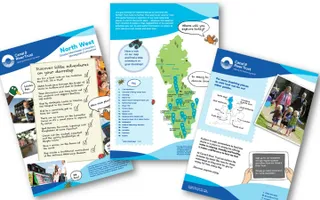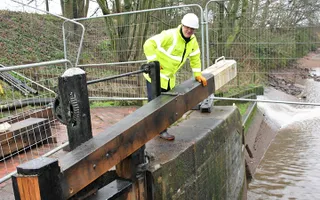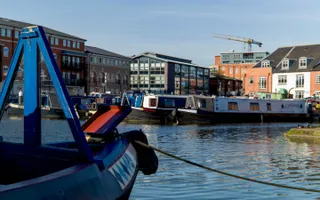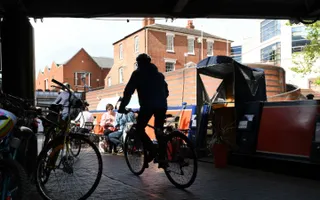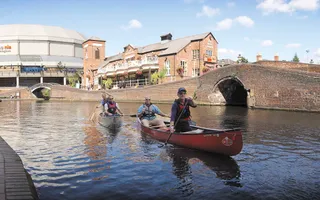The Worcester & Birmingham Canal takes you from the vibrant centre of Birmingham, through the green hills of Worcestershire, to the cathedral city of Worcester.
At its northern end, the canal joins the Birmingham Canal Main Line at Gas Street Basin. This pretty basin was once a thriving transport hub. Now, traditional narrowboats and elegant black and white iron footbridges sit side-by-side with modern bars and restaurants. Close by is luxury shopping centre the Mailbox, with its stylish clothing shops and cafes.
Among the cargos that once travelled on the canal was chocolate crumb to the Cadbury factory. Today, this is Cadbury World, a great day out if you have a sweet tooth.
Chocolate and guillotines
At Kings Norton Junction, the Stratford-upon-Avon Canal joins under permanently open guillotine gates. Opposite the junction is an attractive toll house with its board showing the charges.
The canal was realigned to allow the building of the M42. Tardebigge Wharf, with its dry dock, maintenance yard, workers' cottages, and historic warehouse remains the main base for maintenance on the canal, and is a great place to start a walk. It was here that Tom Rolt met Robert Aickman, which led to the creation of the Inland Waterways Association.
Historic meeting
All 58 locks are in the second half of the canal, as the canal descends through rural Worcestershire. The Tardebigge lock flight has 30 locks in just over two miles, making it the longest in the country.
Hanbury Hall (National Trust) can easily be reached by a pleasant walk across the fields from Astwood Bottom Lock. Hanbury Junction marks the connection with the Droitwich Junction Canal, linked with the Droitwich Barge Canal and offers a route to the River Severn at Hawford. You might like to take a short walk down the Hanbury Flight, which was rebuilt by volunteers. Hanbury's other claim to fame is that it is said to be the real-life counterpart of Radio 4's Ambridge, home of The Archers.
Around Bilford, the countryside is left behind as the canal begins to encroach on the city environs. The Commandery was the headquarters of Charles Stuart before the Battle of Worcester in 1651.
Ahead lies Diglis Basins and two wide locks accessing the Severn. Once very busy with commercial traffic, the working boats have long been replaced by pleasure craft. Worcester Cathedral stares down imposingly on travellers entering the river.
Days out along the Worcester & Birmingham Canal
If you're planning a day out then check out our free family-friendly guides and make sure you get the best from your trip to the canal.
The history
The purpose of the Worcester & Birmingham Canal was to give a much shorter link between Birmingham and the river Severn. Against opposition from other canals, it gained its Act in 1791. Construction started at the Birmingham end but progress was slow. The canal was intended to be broad (for boats up to 14ft wide), which is why the first three tunnels have this width, but shortage of money meant that the section from Tardebigge to Worcester was built only wide enough for narrow boats. It opened throughout in 1815.
Water supply was a major problem and a source of conflict with connecting canals. At first the Birmingham Canal and the W&B were physically separated by what was known as Worcester Bar, but in 1815 they agreed a compromise whereby the two canals would be linked by a lock, with the W&B paying a compensation toll for all traffic passing through.
The guillotine lock (pictured) by Kings Norton Junction on the Stratford-upon-Avon Canal enabled each canal to preserve its water, regardless of the respective levels.
Experimental vertical boat lift
Tardebigge top lock is particularly deep because it was the site of a experimental vertical boat lift, which proved not to be robust enough. After a few months it was replaced by a conventional lock — but as a canal's water usage is largely determined by its deepest lock, it would have been better if it had been replaced by two locks.
The volume of traffic never lived up to expectations, though it improved once the Gloucester & Berkeley Canal opened in 1827. Salt had been found when the canal was being cut at Stoke Prior, and the industry which developed became an important source of traffic. Worcester gas works and other canalside industries used coal brought by the canal.
Railway competition
However, from 1841 railway competition took away much of the business and in 1868 losses were so severe that a receiver was appointed. The canal was saved by being bought in 1874 by the Sharpness New Docks Company (which by then owned the Gloucester & Sharpness Canal). Under enterprising management new traffic was sought, and the canal survived until nationalisation in 1948.
The last commercial traffics were coal from Cannock to Worcester and chocolate crumb from Worcester to Bournville, ceasing in 1960 and 1961 respectively.
Where does the water come from?
Tardebigge Locks
Water supplying the 30 locks on the Tardebigge flight, the longest flight in Britain, comes from several sources. These feed into the Birmingham Level: the 50 mile long pound above the locks. The nearest of these are Upper Bittell & Cofton Reservoirs. Smaller amounts of water come from feeders (diverted streams) e.g. Tutnall Feeder just north of Tardebigge Old Wharf.
Tardebigge Reservoir. built in 1822/23, was filled by excess rainwater from the summit; surplus lockage water from the deep top lock, built on the site of an experimental boat lift and its own catchment.
Originally water from Tardebigge Reservoir was pumped up to the top of the flight by a steam powered beam engine. Today, Tardebigge Reservoir stores excess water from the Birmingham Level for use lower down the flight.
The old Engine House and the remains of the experimental boat lift balancing pit can still be seen near the canal.




